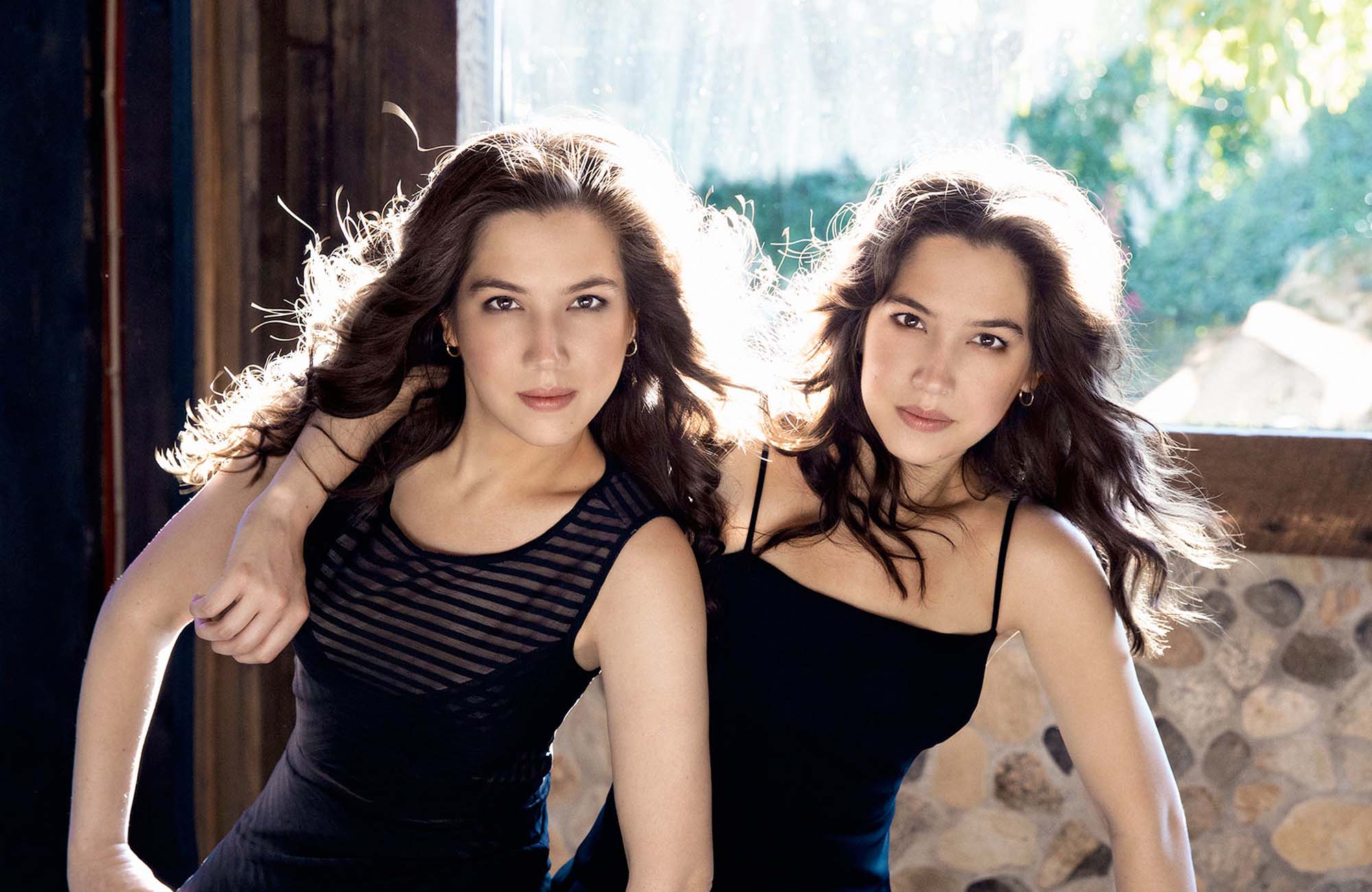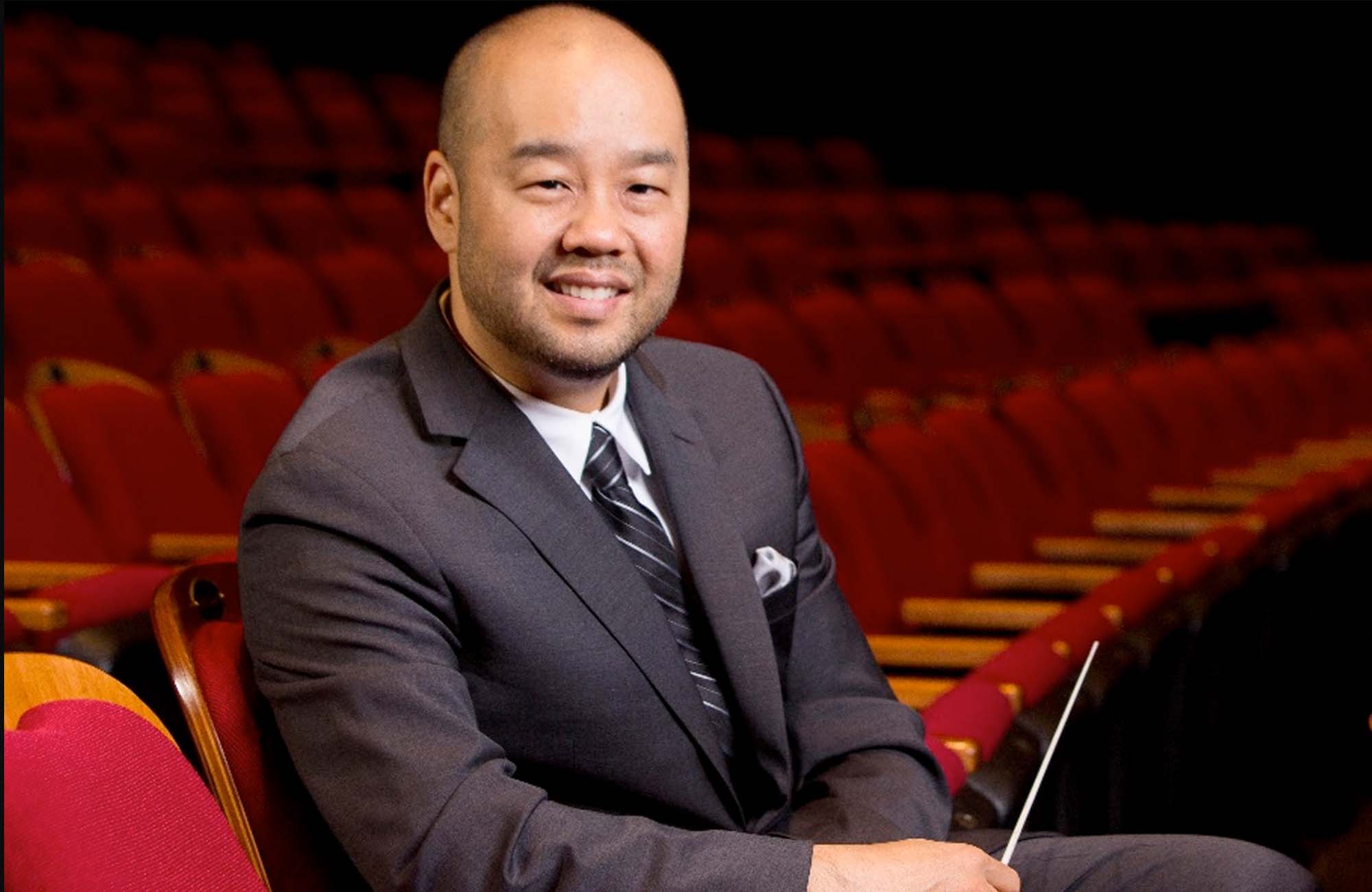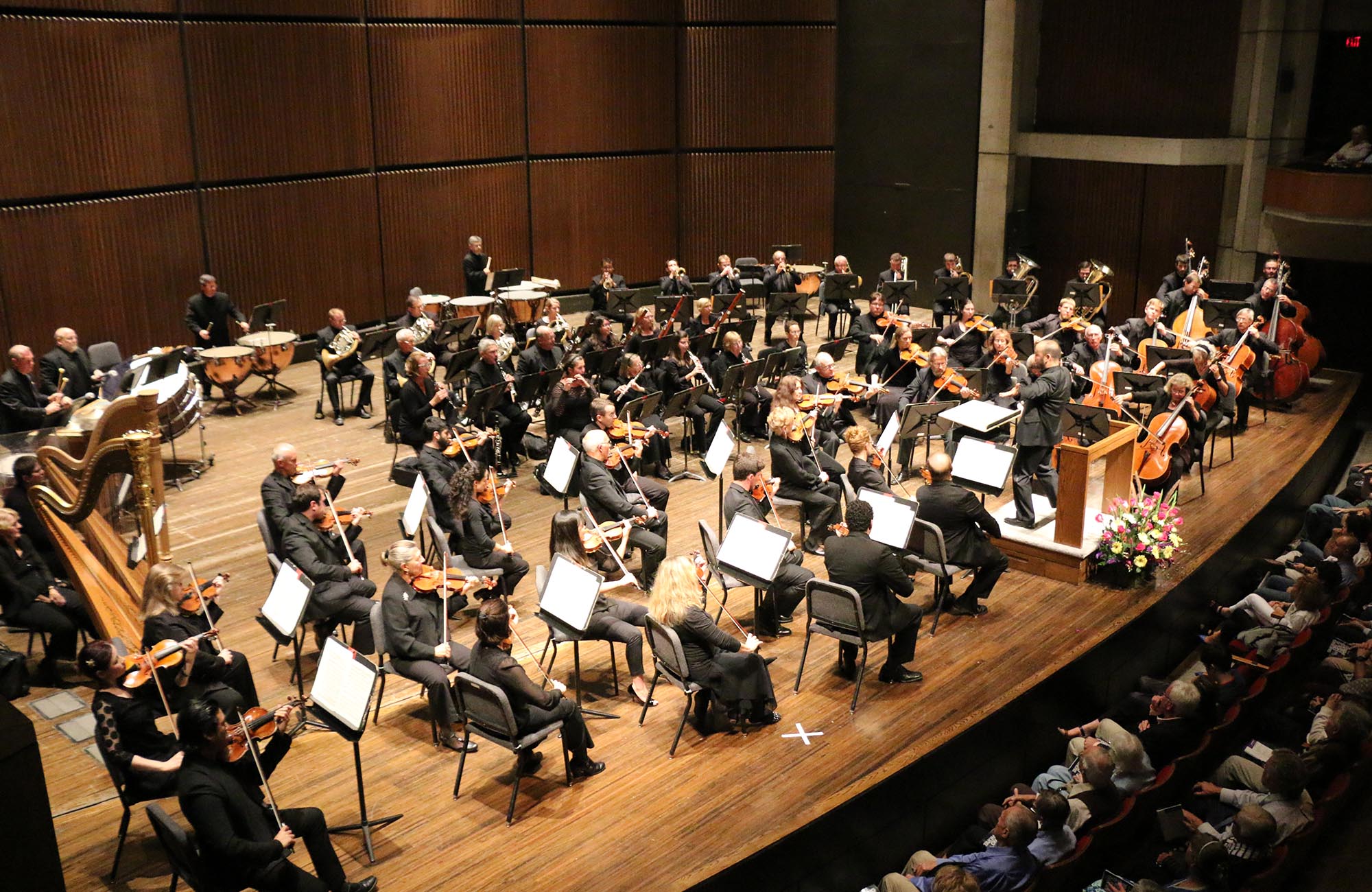PROGRAM
MOZART: Symphony No.29, K.201 (186a), A major
Performed on March 28, 2015 at Crouse Hinds Concert Theater
Lawrence Loh conducting
BRUCH: Concerto for 2 Pianos in A-flat Minor, op.88a
Performed on January 26, 2019 at Crouse Hinds Concert Theater
Christina and Michelle Naughton, pianos; Lawrence Loh conducting
SCHUMANN: Symphony No.3, op.97, E-flat major (Rhenish)
Performed on March 28, 2015 at Crouse Hinds Concert Theater
Lawrence Loh conducting
PROGRAM NOTES
Mozart Symphony No. 29
The Symphony No. 29 (K. 201/186a, 1774), in the sunlit key of A Major, may be the work of a teenager, but it’s a remarkably sophisticated work—and its sheer confidence may explain why it has become the most popular of Mozart’s early symphonies. Written in the wake of a trip to Vienna, where he got a strong jolt of new music, it shows the young composer fusing that exhilarating experience with his earlier influences to produce something original.
Original—and arresting: the opening themes of both the first and last movements include striking ...
Mozart Symphony No. 29
The Symphony No. 29 (K. 201/186a, 1774), in the sunlit key of A Major, may be the work of a teenager, but it’s a remarkably sophisticated work—and its sheer confidence may explain why it has become the most popular of Mozart’s early symphonies. Written in the wake of a trip to Vienna, where he got a strong jolt of new music, it shows the young composer fusing that exhilarating experience with his earlier influences to produce something original.
Original—and arresting: the opening themes of both the first and last movements include striking octave leaps, and one can imagine the young composer flexing his muscles and challenging his imagination. He challenged his players, too. “It’s tremendously difficult for the orchestra,” says conductor Larry Loh, “with really high parts for the horns. There’s something about the sound of the high horn that gives it an exciting, on-the-edge feeling.”
If the Symphony No. 29 shows the young composer at his brightest, the Requiem shows Mozart at his darkest. Even the instrumentation is dark, with the elimination of flutes and horns, and the inclusion of basset horns (a darker cousin of the clarinet), which, in Larry’s words, “adds great color and depth to the winds.” It is also reveals Mozart at his most serious and at his most dramatic, with elaborate Bach-inspired counterpoint and overwhelming choruses.
Bruch Double Piano Concerto
Between these repertoire standards, we’re offering something you probably haven’t encountered before, the Concerto for Two Pianos (1915) by Max Bruch (1838–1920).
Bruch’s position in the repertoire is complex. On the one hand, he’s a familiar composer; on the other hand, beyond a few beloved pieces (the First Violin Concerto, the Scottish Fantasy, the Kol Nidre), most of his output remains virtually unknown. The Double Concerto, in fact, remained doubly unknown—not simply buried in his catalog, but physically lost. It was originally conceived as a suite for organ and orchestra; Bruch, however, adapted it as a concerto for two pianos to fulfill a request by American duo-pianist sisters Ottilie and Rose Sutro. The work was beyond their capacities, however; so before premiering it in 1916 Philadelphia, they radically rewrote the score. The original manuscript only turned up half a century later, when it was finally reconstructed by Nathan Twining and Martin Berkofsky.
The work turns out to be a splendid addition to the repertoire; as our soloists Michelle and Christina Naughton put it, “It’s one of those pieces you wish were played more often.” What’s it like? If you remember their dazzling performance of the Poulenc Double Concerto three years ago, you can prepare yourself for this one by imagining something nearly exactly the opposite. The Poulenc is marked by Gallic wit; the Bruch, as the Naughtons say, is “very not French.” The eclectic Poulenc darts among a wide variety of idioms, including some drawn from non-western music; Bruch is solidly in the Germanic tradition. In contrast to Poulenc’s cool neo-classicism and its traditional three movements (fast-slow-fast), Bruch offers an unapologetic romanticism and an odd four movement structure.
The glowering and highly contrapuntal opening Andante sostenuto is dominated by a theme Bruch heard in a funeral procession while he was in Capri. The pianos announce it straight away, and it serves as basic material for the whole movement. It may seem like a very extended introduction, since it leads directly to the second movement; but that movement, surprisingly, begins with a poignant slow introduction of its own before turning into an Allegro molto vivace that neatly interleaves the rollicking with the intimate. A beguiling slow movement follows, before the two-part finale, which opens with a reworking of the Capri theme before leading to a brilliant, virtuosic close. On the whole, the concerto is fairly serious, yet it’s far from severe. All four movements are stamped with the melodic genius that’s a Bruch trademark. Unfamiliar as it is—as the Naughtons say, “It will be a fresh experience for everyone,” including the orchestra—you may well find yourself humming it at intermission.
One thing the Bruch does share with the Poulenc (indeed, with most two-piano concertos) is a disarming interchange between the two soloists. It’s a balanced interchange, too: rather than having primary and secondary roles, the Naughtons point out, “the parts are distributed pretty equally.” With a laugh, they offer a “random speculation” about that. Many two-piano concertos (for instance, the Mozart K. 365, the Mendelssohn E-Major, and this one) are written for siblings, and they have to be constructed in such a way as to avoid sibling rivalry. Whether or not that’s true, anyone who was here for the Poulenc will know to expect that tonight’s cooperative give-and-take will be …well, unrivaled.
Schumann Symphony No. 3
Coincidentally, our closer, the five-movement Symphony No. 3 (“Rhenish”) by Robert Schumann (1810–1856), begins with an ebullient theme that, Larry points out, plays with the beat in a way that may remind you of the horn theme in Till. On the surface, the symphony’s spirit is quite different from that of Strauss’s tone poem—buoyant where Strauss’s is manic, celebratory where Strauss’s is consciously unruly, marked by an inward glow where Strauss’s is ostentatiously flashy. Still, it shares Till’s profound optimism.
Biographically, its uplift may seem surprising. Schumann wrote the symphony quickly, in little over a month, toward the end of 1850, right after his setting of Byron’s tortured Manfred and just a few years before an attempted suicide led to his institutionalization for the final years of his life. But there’s not a trace of despair in the work, supposedly fueled by a vacation along the Rhine. Yes, the fourth movement (sometimes considered an extended introduction to the fifth) is grave. Said to be inspired—while he was in the middle of composing the work, by a ceremony at the Cologne Cathedral, it begins with a chorale (introduced by trombones) that grows increasingly rich and contrapuntal as the movement continues. But while the music is solemn, it’s far from gloomy; and the other four movements have unbuttoned high spirits.
Peter J. Rabinowitz
Have comments or questions? Contact me at prabinowitz@ExperienceSymphoria.org
FEATURED ARTISTS

Christina and Michelle Naughton have been hailed by The San Francisco Examiner for their “stellar musicianship, technical mastery and awe-inspiring artistry.” They have captivated audiences throughout the globe with the unity engendered by their mystical musical communication. As quoted by The Wall Street Journal, Christina Naughton has said, “There ...
Christina and Michelle Naughton have been hailed by The San Francisco Examiner for their “stellar musicianship, technical mastery and awe-inspiring artistry.” They have captivated audiences throughout the globe with the unity engendered by their mystical musical communication. As quoted by The Wall Street Journal, Christina Naughton has said, “There are times I forget we are two people playing together.”
Recent years have featured the Naughtons as soloists with American orchestras such as the Philadelphia Orchestra, Atlanta, Houston, Baltimore, Detroit, St. Louis, San Diego, Virginia, Milwaukee and New Jersey Symphonies; the Minnesota Orchestra and the Buffalo Philharmonic.
They have also appeared with orchestras around the world such as the Mahler Chamber Orchestra, St Petersberg Philharmonic, Hong Kong Philharmonic, Netherlands Philharmonic (at the Concertgebouw), Royal Scottish National Orchestra, l’Orchestre Philharmonique de Strasbourg, New Zealand Symphony and the Orquesta Sinfonica do Estado Sao Paulo.
American concert series have had Christina and Michelle in such venues as the Kennedy Center’s Terrace Theater, New York City’s Lincoln Center Great Performers Concert series, the Schubert Club in St Paul, Los Angeles’s Walt Disney Concert Hall, Boston’s Isabella Stewart Gardner Museum, and Fort Worth’s Cliburn Concerts. International recital highlights include Berlin’s Kammermusiksaal, Munich’s Herkulesaal, Zurich’s Tonhalle, Beijing’s Forbidden City Concert Hall, and Mexico City’s Pallacio de las Bellas Artes.
They have also appeared at summer festivals such as at France’s La Roque d’Antheron, Germany’s Kissinger Sommer, Chicago’s Ravinia Festival, La Jolla Summerfest and Wyoming’s Grand Tetons Festival. In February 2016 the Naughtons released their debut record on the Warner Classics label, titled “Visions,” featuring the music of Messiaen, Bach and Adams. The album received much critical acclaim, with The Washington Post hailing them as one of the “greatest piano duos of our time.” The record was chosen as “Editor’s Choice” in Gramophone magazine.
Born in Princeton, New Jersey, to parents of European and Chinese descent, Christina and Michelle are graduates of the Juilliard School and the Curtis Institute of Music, where they were each awarded the Festorazzi Prize. They are Steinway Artists and currently reside in New York City.

Described as bringing an “artisan storyteller’s sensitivity… shaping passages with clarity and power via beautifully sculpted dynamics… revealing orchestral character not seen or heard before” (Arts Knoxville) Lawrence Loh enjoys a dynamic career as a conductor of orchestras all over the world.
After an extensive two ...
Described as bringing an “artisan storyteller’s sensitivity… shaping passages with clarity and power via beautifully sculpted dynamics… revealing orchestral character not seen or heard before” (Arts Knoxville) Lawrence Loh enjoys a dynamic career as a conductor of orchestras all over the world.
After an extensive two year search, Lawrence Loh was recently named Music Director of the Waco Symphony Orchestra beginning in the Spring of 2024. Since 2015, he has served as Music Director of The Syracuse Orchestra (formerly called Symphoria), the successor to the Syracuse Symphony Orchestra. “The connection between the organization and its audience is one of the qualities that’s come to define Syracuse’s symphony as it wraps up its 10th season, a milestone that might have seemed impossible at the beginning,” (Syracuse.com) The Syracuse Orchestra and Lawrence Loh show that it is possible to create a “new, more sustainable artistic institution from the ground up.”
Appointed Assistant Conductor of the Pittsburgh Symphony in 2005, Mr Loh was quickly promoted to Associate and Resident Conductor within the first three years of working with the PSO. Always a favorite among Pittsburgh audiences, Loh returns frequently to his adopted city to conduct the PSO in a variety of concerts. Mr. Loh previously served as Music Director of the West Virginia Symphony Orchestra, Music Director of the Northeastern Pennsylvania Philharmonic, Artistic Director and Principal Conductor of the Syracuse Opera, Music Director of the Pittsburgh Youth Symphony Orchestra, Associate Conductor of the Dallas Symphony Orchestra, Associate Conductor of the Colorado Symphony Orchestra and Music Director of the Denver Young Artists Orchestra.
Mr. Loh’s recent guest conducting engagements include the San Francisco Symphony, Dallas Symphony, North Carolina Symphony, Baltimore Symphony, Sarasota Orchestra, Florida Orchestra, Pensacola Symphony, Atlanta Symphony, National Symphony, Detroit Symphony, San Diego Symphony, Seattle Symphony, National Symphony (D.C.), Utah Symphony, Rochester Philharmonic, Indianapolis Symphony, Calgary Philharmonic, Buffalo Philharmonic, Albany Symphony and the Cathedral Choral Society at the Washington National Cathedral. His summer appearances include the festivals of Grant Park, Boston University Tanglewood Institute, Tanglewood with the Boston Pops, Chautauqua, Sun Valley, Shippensburg, Bravo Vail Valley, the Kinhaven Music School and the Performing Arts Institute (PA).
As a self-described “Star Wars geek” and film music enthusiast, Loh has conducted numerous sold-out John Williams and film music tribute concerts. Part of his appeal is his ability to serve as both host and conductor. “It is his enthusiasm for Williams’ music and the films for which it was written that is Loh’s great strength in this program. A fan’s enthusiasm drives his performances in broad strokes and details and fills his speaking to the audience with irresistible appeal. He used no cue cards. One felt he could speak at filibuster length on Williams’ music.” (Pittsburgh Tribune)
Mr Loh has assisted John Williams on multiple occasions and has worked with a wide range of pops artists from Chris Botti and Ann Hampton Callaway to Jason Alexander and Idina Menzel. As one of the most requested conductors for conducting Films in Concert, Loh has led Black Panther, Star Wars (Episodes 4-6), Jaws, Nightmare Before Christmas, Jurassic Park, Casablanca, The Wizard of Oz and Singin’ in the Rain, among other film productions.
Lawrence Loh received his Artist Diploma in Orchestral Conducting from Yale, his Masters in Choral Conducting from Indiana University and his Bachelor of Arts from the University of Rochester. Lawrence Loh was born in southern California of Korean parentage and raised in Carlisle, Pennsylvania. He and his wife Jennifer have a son, Charlie, and a daughter, Hilary. Follow him on instagram @conductorlarryloh or Facebook at @lawrencelohconductor or visit his website, www.lawrenceloh.com


